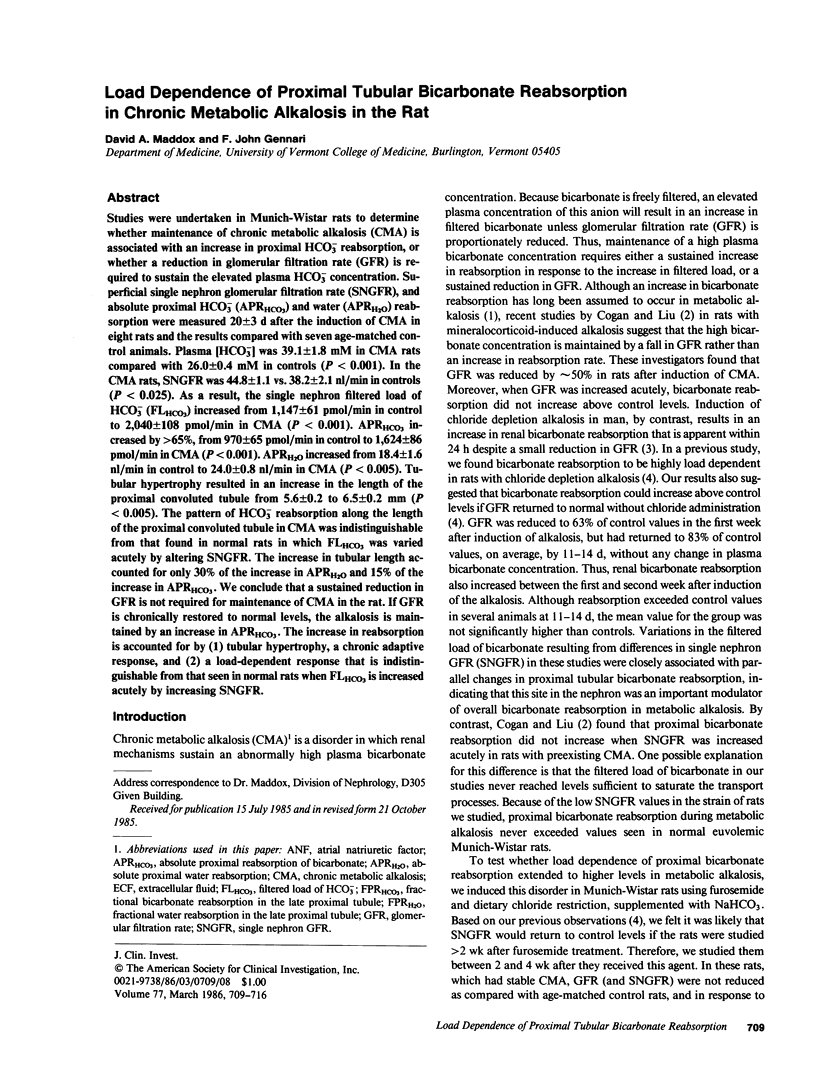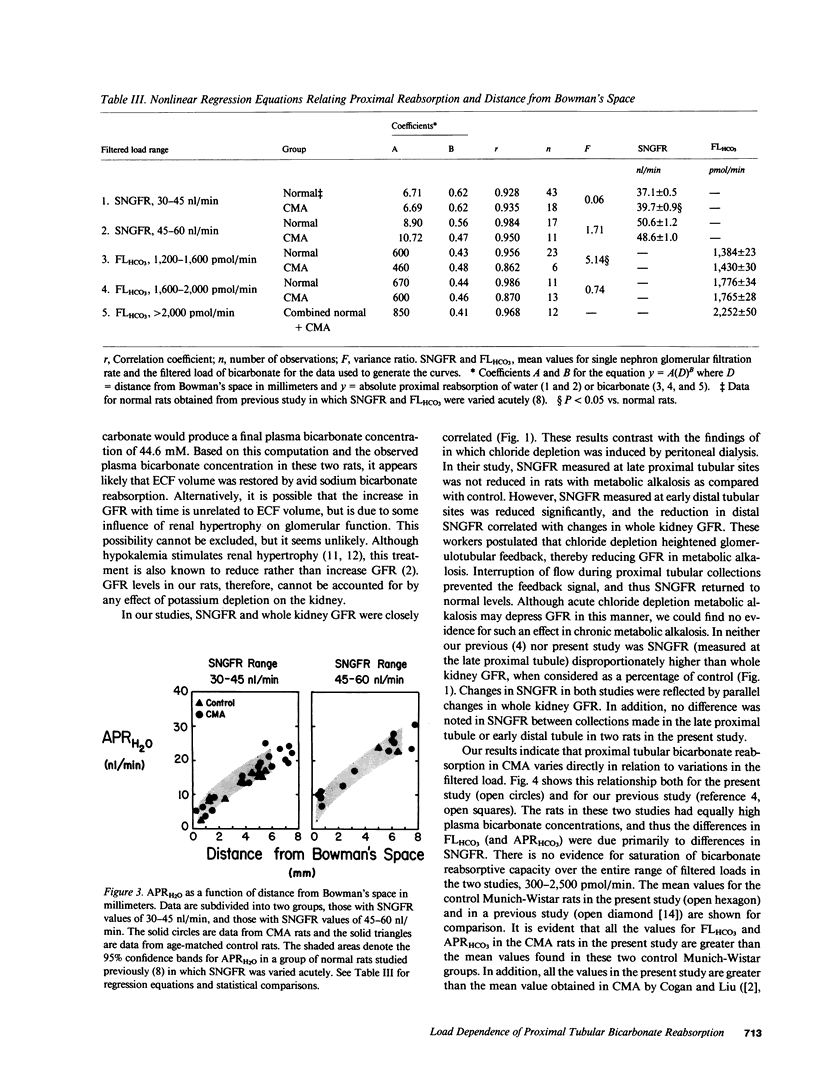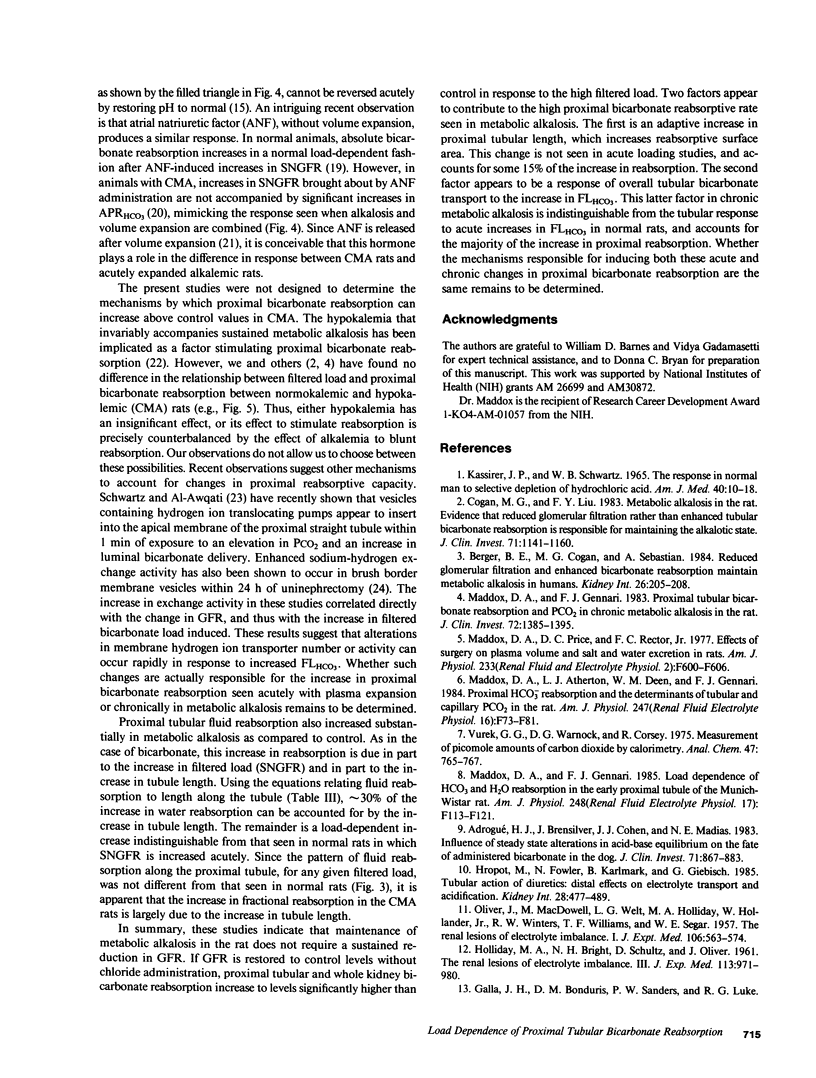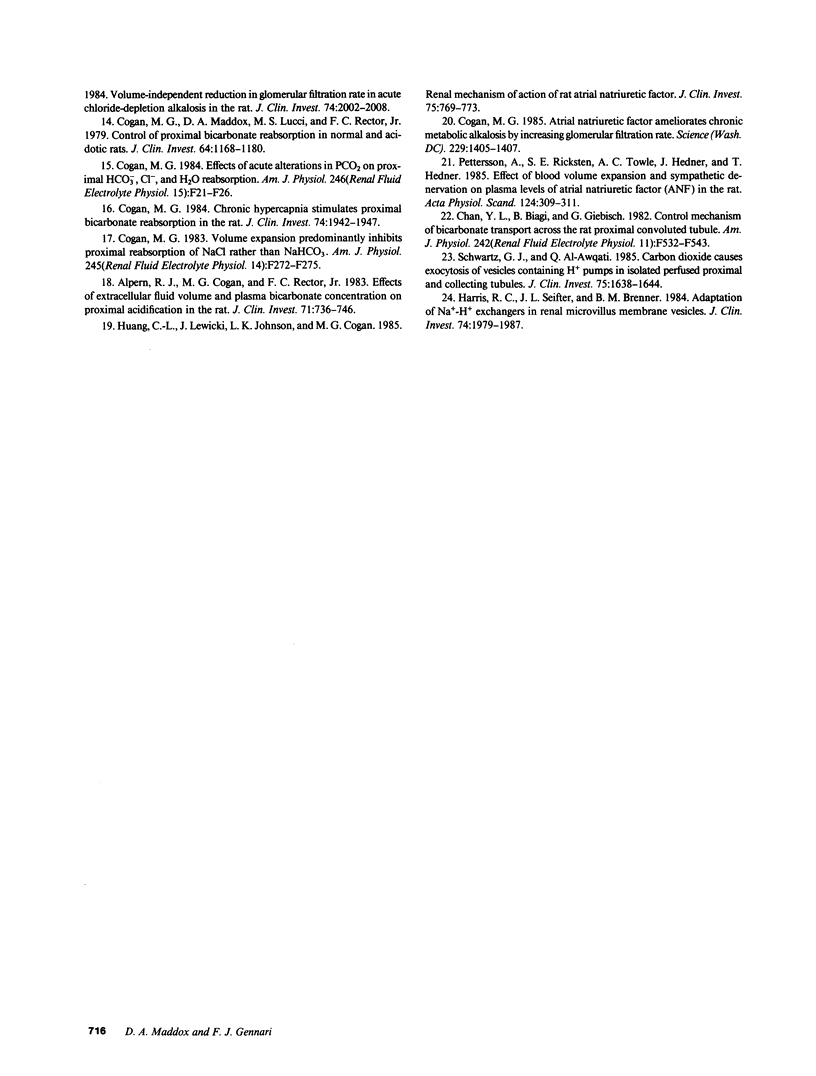Abstract
Studies were undertaken in Munich-Wistar rats to determine whether maintenance of chronic metabolic alkalosis (CMA) is associated with an increase in proximal HCO3- reabsorption, or whether a reduction in glomerular filtration rate (GFR) is required to sustain the elevated plasma HCO3- concentration. Superficial single nephron glomerular filtration rate (SNGFR), and absolute proximal HCO-3 (APRHCO3) and water (APRH2O) reabsorption were measured 20 +/- 3 d after the induction of CMA in eight rats and the results compared with seven age-matched control animals. Plasma [HCO3-] was 39.1 +/- 1.8 mM in CMA rats compared with 26.0 +/- 0.4 mM in controls (P less than 0.001). In the CMA rats, SNGFR was 44.8 +/- 1.1 vs. 38.2 +/- 2.1 nl/min in controls (P less than 0.025). As a result, the single nephron filtered load of HCO3- (FLHCO3) increased from 1,147 +/- 61 pmol/min in control to 2,040 +/- 108 pmol/min in CMA (P less than 0.001). APRHCO3 increased by greater than 65%, from 970 +/- 65 pmol/min in control to 1,624 +/- 86 pmol/min in CMA (P less than 0.001). APRH2O increased from 18.4 +/- 1.6 nl/min in control to 24.0 +/- 0.8 nl/min in CMA (P less than 0.005). Tubular hypertrophy resulted in an increase in the length of the proximal convoluted tubule from 5.6 +/- 0.2 to 6.5 +/- 0.2 mm (P less than 0.005). The pattern of HCO3- reabsorption along the length of the proximal convoluted tubule in CMA was indistinguishable from that found in normal rats in which FLHCO3 was varied acutely by altering SNGFR. The increase in tubular length accounted for only 30% of the increase in APRH2O and 15% of the increase in APRHCO3. We conclude that a sustained reduction in GFR is not required for maintenance of CMA in the rat. If GFR is chronically restored to normal levels, the alkalosis is maintained by an increase in APRHCO3. The increase in reabsorption is accounted for by tubular hypertrophy, a chronic adaptive response, and a load-dependent response that is indistinguishable from that seen in normal rats when FLHCO3 is increased acutely by increasing SNGFR.
Full text
PDF







Selected References
These references are in PubMed. This may not be the complete list of references from this article.
- Adrogué H. J., Brensilver J., Cohen J. J., Madias N. E. Influence of steady-state alterations in acid-base equilibrium on the fate of administered bicarbonate in the dog. J Clin Invest. 1983 Apr;71(4):867–883. doi: 10.1172/JCI110841. [DOI] [PMC free article] [PubMed] [Google Scholar]
- Alpern R. J., Cogan M. G., Rector F. C., Jr Effects of extracellular fluid volume and plasma bicarbonate concentration on proximal acidification in the rat. J Clin Invest. 1983 Mar;71(3):736–746. doi: 10.1172/JCI110821. [DOI] [PMC free article] [PubMed] [Google Scholar]
- Berger B. E., Cogan M. G., Sebastian A. Reduced glomerular filtration and enhanced bicarbonate reabsorption maintain metabolic alkalosis in humans. Kidney Int. 1984 Aug;26(2):205–208. doi: 10.1038/ki.1984.157. [DOI] [PubMed] [Google Scholar]
- Chan Y. L., Biagi B., Giebisch G. Control mechanisms of bicarbonate transport across the rat proximal convoluted tubule. Am J Physiol. 1982 May;242(5):F532–F543. doi: 10.1152/ajprenal.1982.242.5.F532. [DOI] [PubMed] [Google Scholar]
- Cogan M. G. Atrial natriuretic factor ameliorates chronic metabolic alkalosis by increasing glomerular filtration. Science. 1985 Sep 27;229(4720):1405–1407. doi: 10.1126/science.2930899. [DOI] [PubMed] [Google Scholar]
- Cogan M. G. Chronic hypercapnia stimulates proximal bicarbonate reabsorption in the rat. J Clin Invest. 1984 Dec;74(6):1942–1947. doi: 10.1172/JCI111614. [DOI] [PMC free article] [PubMed] [Google Scholar]
- Cogan M. G. Effects of acute alterations in PCO2 on proximal HCO-3, Cl-, and H2O reabsorption. Am J Physiol. 1984 Jan;246(1 Pt 2):F21–F26. doi: 10.1152/ajprenal.1984.246.1.F21. [DOI] [PubMed] [Google Scholar]
- Cogan M. G., Liu F. Y. Metabolic alkalosis in the rat. Evidence that reduced glomerular filtration rather than enhanced tubular bicarbonate reabsorption is responsible for maintaining the alkalotic state. J Clin Invest. 1983 May;71(5):1141–1160. doi: 10.1172/JCI110864. [DOI] [PMC free article] [PubMed] [Google Scholar]
- Cogan M. G., Maddox D. A., Lucci M. S., Rector F. C., Jr Control of proximal bicarbonate reabsorption in normal and acidotic rats. J Clin Invest. 1979 Nov;64(5):1168–1180. doi: 10.1172/JCI109570. [DOI] [PMC free article] [PubMed] [Google Scholar]
- Cogan M. G. Volume expansion predominantly inhibits proximal reabsorption of NaCl rather than NaHCO3. Am J Physiol. 1983 Aug;245(2):F272–F275. doi: 10.1152/ajprenal.1983.245.2.F272. [DOI] [PubMed] [Google Scholar]
- HOLLIDAY M. A., BRIGHT N. H., SCHULZ D., OLIVER J. The renal lesions of electrolyte imbalance. III. The effect of acute chloride depletion and alkalosis on the renal cortex. J Exp Med. 1961 Jun 1;113:971–980. doi: 10.1084/jem.113.6.971. [DOI] [PMC free article] [PubMed] [Google Scholar]
- Harris R. C., Seifter J. L., Brenner B. M. Adaptation of Na+-H+ exchange in renal microvillus membrane vesicles. Role of dietary protein and uninephrectomy. J Clin Invest. 1984 Dec;74(6):1979–1987. doi: 10.1172/JCI111619. [DOI] [PMC free article] [PubMed] [Google Scholar]
- Hropot M., Fowler N., Karlmark B., Giebisch G. Tubular action of diuretics: distal effects on electrolyte transport and acidification. Kidney Int. 1985 Sep;28(3):477–489. doi: 10.1038/ki.1985.154. [DOI] [PubMed] [Google Scholar]
- Huang C. L., Lewicki J., Johnson L. K., Cogan M. G. Renal mechanism of action of rat atrial natriuretic factor. J Clin Invest. 1985 Feb;75(2):769–773. doi: 10.1172/JCI111759. [DOI] [PMC free article] [PubMed] [Google Scholar]
- Kassirer J. P., Schwartz W. B. The response of normal man to selective depletion of hydrochloric acid. Factors in the genesis of persistent gastric alkalosis. Am J Med. 1966 Jan;40(1):10–18. doi: 10.1016/0002-9343(66)90182-3. [DOI] [PubMed] [Google Scholar]
- Maddox D. A., Gennari F. J. Load dependence of HCO3 and H2O reabsorption in the early proximal tubule of the Munich-Wistar rat. Am J Physiol. 1985 Jan;248(1 Pt 2):F113–F121. doi: 10.1152/ajprenal.1985.248.1.F113. [DOI] [PubMed] [Google Scholar]
- Maddox D. A., Gennari F. J. Proximal tubular bicarbonate reabsorption and PCO2 in chronic metabolic alkalosis in the rat. J Clin Invest. 1983 Oct;72(4):1385–1395. doi: 10.1172/JCI111095. [DOI] [PMC free article] [PubMed] [Google Scholar]
- Maddox D. A., Price D. C., Rector F. C., Jr Effects of surgery on plasma volume and salt and water excretion in rats. Am J Physiol. 1977 Dec;233(6):F600–F606. doi: 10.1152/ajprenal.1977.233.6.F600. [DOI] [PubMed] [Google Scholar]
- OLIVER J., MACDOWELL M., WELT L. G., HOLLIDAY M. A., HOLLANDER W., Jr, WINTERS R. W., WILLIAMS T. F., SEGAR W. E. The renal lesions of electrolyte imbalance. I. The structural alterations in potassium-depleted rats. J Exp Med. 1957 Oct 1;106(4):563–574. doi: 10.1084/jem.106.4.563. [DOI] [PMC free article] [PubMed] [Google Scholar]
- Pettersson A., Ricksten S. E., Towle A. C., Hedner J., Hedner T. Effect of blood volume expansion and sympathetic denervation on plasma levels of atrial natriuretic factor (ANF) in the rat. Acta Physiol Scand. 1985 Jun;124(2):309–311. doi: 10.1111/j.1748-1716.1985.tb07665.x. [DOI] [PubMed] [Google Scholar]
- Schwartz G. J., Al-Awqati Q. Carbon dioxide causes exocytosis of vesicles containing H+ pumps in isolated perfused proximal and collecting tubules. J Clin Invest. 1985 May;75(5):1638–1644. doi: 10.1172/JCI111871. [DOI] [PMC free article] [PubMed] [Google Scholar]
- Vurek G. G., Warnock D. G., Corsey R. Measurement of picomole amounts of carbon dioxide by calorimetry. Anal Chem. 1975 Apr;47(4):765–767. doi: 10.1021/ac60354a024. [DOI] [PubMed] [Google Scholar]


